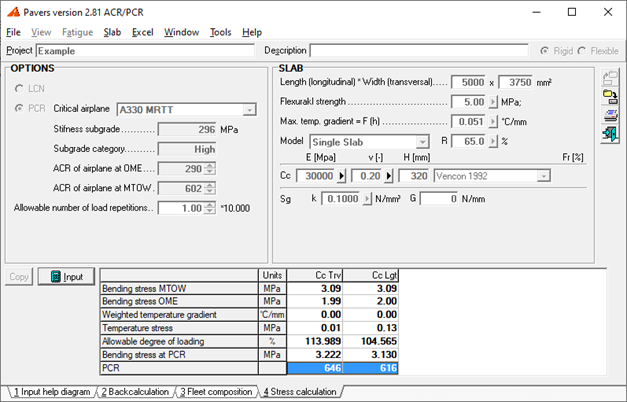Limitations of the ACR-PCR System
The ACR-PCR system is only intended as a method that airport operators can use to evaluate acceptable operations of aircraft. It is not intended as a pavement design or pavement evaluation procedure, nor does it restrict the methodology used to design or evaluate a pavement structure. There is no mathematical correlation between the previous ICAO pavement strength reporting ACN-PCN and the new ICAO ACR-PCR system.
Assigning PCR to a pavement using PAVERS
A number of methods can be used by an airport authority to determine the rating of a pavement in terms of PCR.
The first method is known as the Using aircraft method, and can be applied with limited knowledge of the existing traffic and runway characteristics. The terminology Using aircraft simply means that the PCR is based on the aircraft currently and satisfactorily using the pavement, and there are no engineering methods or technical analysis employed to arrive at this sort of PCR.
The second method, known as the Technical evaluation method, requires a much more intimate knowledge of the pavement and its traffic, as well as a basic understanding of engineering methods that are utilized in pavement evaluation in order to be successfully implemented. All of the factors that contribute towards pavement analysis, such as existing and forecasted traffic, aircraft characteristics, pavement design parameters, and engineering experience are applied in arriving realistic and comparable PCRs.
Iimplementation of calibrated design criteria into modern software tool such as PAVERS allow the designer to access the full advantages of the layered elastic method, including treatment of wander, and quickly produce PCR-numbers that are consistent with the original design concept. The Pavers concept is equipped to calculate realistic PCR-numbers.

Example of reporting PCN
A rigid pavement with 10.000 equivalent passes of an A330, a subgrade CBR of ≥ 15, a numeric value of 616 is determined by a technical method, and having an unlimited tire pressure is reported as 616 R/A/W/T.
A summary list of the steps required for PCR-assignment as based on the Technical evaluation method is as follows:
- Determine the pavement's structural design life
- Assess the pavement structure in terms of constructed thickness’, elastic moduli and Poisson ratio’s.
- Determine the pavement’s layer fatigue properties, including subgrade CBR.
- Determine the traffic volume in terms of type of aircraft and number of past and future operations of each aircraft that the pavement had and will experienced over its PCR pavement life course;
- Look up or calculate the ACRs of the aircraft at its operating empty (OEW) and maximum weight and at maximum takeoff weight (MTOW);
- Determine the degree of lateral wander for the pavement under consideration;
- Determine the critical pavement layer i.e. the constructed layer with the lowest bearing capacity or highest damage factor;
- Determine the critical aircraft of the forecasted fleet mix in terms of structural damage by simply taking the aircraft with the highest ACR or by determining the damage factors by means of calculation. A damage factor is the reciproke value of the allowable number of allowable aircraft passes. The ACRs at OEW and MTOW of that so-called critical aircraft are to be used in the PCR evaluation.
- Calculate the accumulated pavement damage in terms of Palmgren-Miner due to the forecasted fleet (incl. wander and for the PCR-pavement life course).
- Compute the Allowable Gross Weight (AGW) of the critical aircraft by varying the load of the undercarriage of the critical aircraft resulting in the same Miner damage as computed in the previous step;
- Once the allowable load (or weight) is established, the determination of the PCR value is a process of converting that load to a standard relative damage value (i.e. ACR). Look up the ACR using the published ACR data, and calculate the ACR of the critical aircraft at its allowable, maximum weight;
- Assign the ACR of the critical aircraft at the allowable, maximum weight to be the PCR of the pavement.
The Pavers program has all capabilities to assist you in reporting realistic and reproducible PCR-numbers that are consistent with the true pavement life, material strengths and fleet mix usage.
